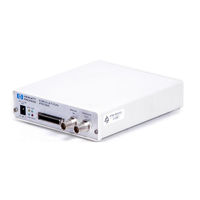HP 16610A Emulation Module Control Manuals
Manuals and User Guides for HP 16610A Emulation Module Control. We have 1 HP 16610A Emulation Module Control manual available for free PDF download: User Manual
HP 16610A User Manual (171 pages)
Emulation for the PowerPC MPC500
Brand: HP
|
Category: Control Unit
|
Size: 4.39 MB
Table of Contents
Advertisement
Advertisement
